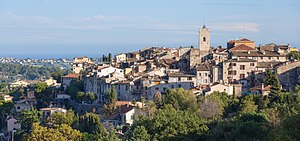Vence
| Vence | ||
|---|---|---|

|
|
|
| region | Provence-Alpes-Cote d'Azur | |
| Department | Alpes-Maritimes | |
| Arrondissement | Grasse | |
| Canton | Vence | |
| Community association | Nice Cote d'Azur | |
| Coordinates | 43 ° 43 ' N , 7 ° 7' E | |
| height | 40–1,033 m | |
| surface | 39.23 km 2 | |
| Residents | 18,465 (January 1, 2017) | |
| Population density | 471 inhabitants / km 2 | |
| Post Code | 06140 | |
| INSEE code | 06157 | |
| Website | vence.fr | |
 View of Vence |
||
Vence ([ vɛ̃s ], Occitan Vença ) is a French commune with 18,465 inhabitants (as of January 1, 2017) in the Alpes-Maritimes department in the Provence-Alpes-Côte d'Azur region . Vence is located in the Arrondissement of Grasse . The municipality is part of the Nice Côte d'Azur metropolis . The place covers an area of 39.23 km². The inhabitants of Vence are the Vençois . Vence is one of the famous travel destinations in Provence. It is perched high on a rock, can be reached quickly from the coast and has the character of a barely touched prealpine town.
Population development
| year | 1962 | 1968 | 1975 | 1982 | 1990 | 1999 | 2006 | 2016 |
|---|---|---|---|---|---|---|---|---|
| Residents | 7874 | 9420 | 11,385 | 13,119 | 15,330 | 16,982 | 18,931 | 18,599 |
Sources: Cassini and INSEE
history
Settled early by Ligurian Celts , the area became 16 BC. Conquered by the Romans and incorporated into the Roman Empire as the province of Alpes Maritimae . Vence became an important Roman settlement, as evidenced by many finds. The foundations of the cathedral are also of Roman origin.
With the spread of Christianity , Vence became a diocese . In the Roman Civitas Vintium there was a bishop from the 4th century. This smallest diocese in France existed until the French Revolution ( see also: List of the Bishops of Vence ).
After Charlemagne , Vence belonged to the Holy Roman Empire of the German Nation . In 1481 Provence was annexed to France and Vence to French. In the 16th century, Francis I had the city beautified. Vence remained Catholic during the Wars of Religion .
The 20th century brought Vence - attracted by the pleasant climate and the special light - tourism and artists , through which the city experienced an economic and cultural boom.
In 1933, the Freinet couple bought a piece of land in the Le Pioulier district and built the École Moderne (today: École Freinet ) there in order to implement their own educational reform ideas.
Attractions
See also: List of Monuments historiques in Vence
The entire old town is enclosed by a city wall, through which numerous gates lead into the city center. One of the most famous is the Porte de Peyra. The way to the old town leads via the Place du Grand-Jardin and the Place du Frene, where there is a huge ash tree that was planted in 1538.
- Old town
- Porte du Peyra with Peyra fountain
- The Romanesque Cathedral de la Nativité-de-Marie from the 11th century is built on Roman foundations.
- The “Vençoise”, a sculpture by Jim Ritchie , on Clemenceau Square in front of the City Hall
- The chapel of the Dominican Sisters , the Chapelle du Rosaire (Rosary Chapel), was designed by Henri Matisse .
- Former Chapel of the White Penitents (Chapelle des Pénitents Blancs)
- Place du Grand Jardin (market)
Town twinning
Vence maintains partnerships with cities
- Lahnstein , Germany , since 1969
- Ouahigouya , Burkina Faso , since 1978
- Stamford , United Kingdom , since 1978
Personalities
A large number of artists chose Vence as their place of residence.
- Maurice Boitel (1919–2007), French painter
- Henri Calet (1904–1956), writer
- Marc Chagall (1887–1985), Belarusian-French painter
- Raoul Dufy (1877–1953), French painter
- Célestin Freinet (1896–1966), educator
- Witold Gombrowicz (1904–1969), Polish writer
- Curd Jürgens (1915–1982), German-Austrian film and stage actor
- DH Lawrence , ( David Herbert Lawrence ) (1885–1930), English writer
- Henri Matisse (1869–1954), French painter
- Jean Vincent de Crozals (1922–2009), French painter and sculptor
- Gwen Raverat (1885–1957), artist and writer, and Jacques Raverat (1885–1925), artist
- Jim Ritchie (* 1929), Canadian sculptor
- Ida Rubinstein (1885–1960), Russian dancer, actress and choreographer
- René Schickele (1883–1940), German-French writer, essayist and translator
literature
- Le Patrimoine des Communes des Alpes-Maritimes . Flohic Editions, Volume 2, Paris 2000, ISBN 2-84234-071-X , pp. 956-967.
Individual evidence
Web links
- Website of the municipality of Vence (French)







